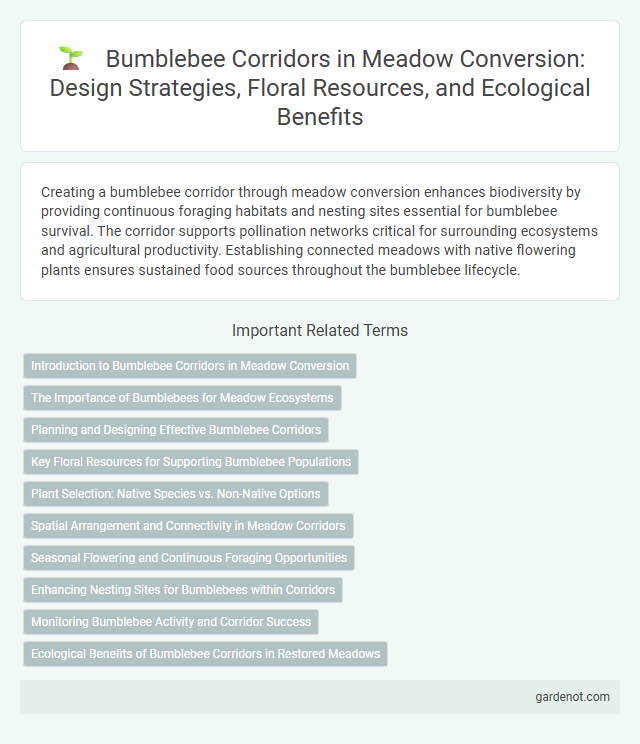Creating a bumblebee corridor through meadow conversion enhances biodiversity by providing continuous foraging habitats and nesting sites essential for bumblebee survival. The corridor supports pollination networks critical for surrounding ecosystems and agricultural productivity. Establishing connected meadows with native flowering plants ensures sustained food sources throughout the bumblebee lifecycle.
Introduction to Bumblebee Corridors in Meadow Conversion
Bumblebee corridors are strategic habitat strips designed to connect fragmented meadow landscapes, enhancing bumblebee foraging and nesting opportunities. These corridors increase floral diversity and availability, supporting bumblebee populations critical for pollination services in agricultural and natural ecosystems. Implementing bumblebee corridors within meadow conversion projects promotes biodiversity and ecosystem resilience by facilitating pollinator movement and gene flow.
The Importance of Bumblebees for Meadow Ecosystems
Bumblebees play a crucial role in meadow ecosystems by facilitating pollination, which supports the reproduction of wildflowers and maintains plant biodiversity. Their efficient foraging behavior enhances seed production, directly contributing to the health and resilience of meadows. Establishing a bumblebee corridor helps connect fragmented habitats, ensuring genetic diversity and sustainability of both bumblebee populations and meadow flora.
Planning and Designing Effective Bumblebee Corridors
Planning and designing effective bumblebee corridors requires identifying key habitats with diverse native flowering plants that provide continuous nectar sources throughout the active seasons. Incorporating a variety of vegetation layers from ground cover to shrubs enhances nesting opportunities and thermal regulation for bumblebee populations. Strategic placement of corridors connects fragmented meadows, facilitating gene flow and increasing resilience against environmental stressors.
Key Floral Resources for Supporting Bumblebee Populations
Key floral resources in bumblebee corridors include native wildflowers such as clover, foxglove, and bellflower, which provide essential nectar and pollen throughout the bumblebee foraging season. Diverse meadow plantings enhance floral diversity, ensuring continuous bloom periods that support colony growth and reproduction. Preserving and planting these key species fosters resilient bumblebee populations by sustaining their nutritional needs and habitat connectivity.
Plant Selection: Native Species vs. Non-Native Options
Selecting native plant species for bumblebee corridors enhances habitat suitability by providing familiar nectar and pollen sources essential for native bee populations. Non-native options may offer extended bloom periods but risk disrupting local ecosystems and reducing overall biodiversity. Prioritizing indigenous flora supports ecological balance and maximizes pollinator conservation efforts in meadow conversions.
Spatial Arrangement and Connectivity in Meadow Corridors
The spatial arrangement of bumblebee corridors in meadow conversion projects enhances habitat connectivity by linking fragmented flower-rich patches, facilitating efficient foraging and gene flow among bumblebee populations. Strategically placed meadow corridors, designed with diverse native flora, create continuous pathways that support bumblebee movement and nesting, increasing pollination services across agricultural landscapes. Optimal connectivity in these corridors reduces population isolation, contributing to the overall resilience and biodiversity of bumblebee species in converted meadow ecosystems.
Seasonal Flowering and Continuous Foraging Opportunities
The Bumblebee corridor promotes seasonal flowering by integrating native wildflowers that bloom sequentially from spring through autumn, ensuring continuous foraging opportunities for bumblebees. This strategic planting supports bumblebee populations by providing diverse nectar and pollen sources throughout their active periods. Continuous floral availability within the corridor enhances pollination efficiency and contributes to ecosystem resilience.
Enhancing Nesting Sites for Bumblebees within Corridors
Enhancing nesting sites for bumblebees within corridors involves creating diverse floral resources and maintaining undisturbed soil patches to support colony establishment and growth. Incorporating native wildflowers and nesting materials such as bare ground, tussock grasses, and decaying wood increases nesting opportunities and improves bumblebee population resilience. Strategic placement of these habitats within Bumblebee corridors strengthens pollination networks and boosts local biodiversity.
Monitoring Bumblebee Activity and Corridor Success
Monitoring bumblebee activity within the Bumblebee Corridor involves tracking species diversity, foraging patterns, and population density to assess habitat quality. Using real-time data collection through sensor technology and citizen science initiatives provides detailed insights into pollinator health and corridor viability. These monitoring efforts support adaptive management strategies that enhance meadow restoration and promote bumblebee population growth across fragmented landscapes.
Ecological Benefits of Bumblebee Corridors in Restored Meadows
Bumblebee corridors in restored meadows significantly enhance local biodiversity by providing essential foraging habitats and nesting sites, which support robust bumblebee populations. These corridors facilitate gene flow and pollination services, boosting the resilience and productivity of surrounding ecosystems. Improved connectivity within landscapes through these corridors also helps mitigate the effects of habitat fragmentation and climate change on bumblebee species.
Bumblebee corridor Infographic

 gardenot.com
gardenot.com